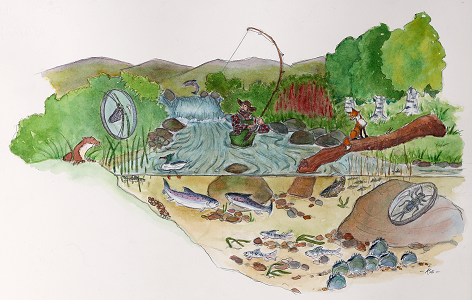Food webs in rivers and oceans - fill the board
In this assignment, you will learn more about the food chains and food webs that wild salmon are part of.
Competency goals for grade 7
- explain how organisms can be divided into main groups and give examples of the characteristics of different organisms.
- explain the importance of biodiversity and implement measures to preserve biodiversity in the local environment.
- propose measures to preserve biodiversity in the High North and provide examples of the importance of traditional knowledge in nature management.
- explore and describe different food webs and use this to discuss interactions in nature.
Find the answers and create business networks
Over the course of their lives, wild salmon spend time in rivers, seas and oceans. These environments are very different in terms of both food animals (animals that wild salmon eat) and predators (animals that eat wild salmon).
The teacher will give you a note. On the note is the name of one of the animals from the list below.
Algae, caddisfly larvae, stonefly larvae, mosquito larvae, water vole, spawning salmon, young trout, young salmon, sea eagle, trout (in the river), salmon duck, otter, seal, salmon in the sea, sea trout, gull, cormorant, shark, cod, saithe, killer whale, krill, capelin, squid.
Find out as much as you can about the animal you were given and answer the questions:
Is your animal a herbivore, a carnivore or both?
Is your animal connected to freshwater, seawater or both?
Can you find an animal on the list that your pet eats?
Can you find an animal on the list that your pet is food for?
Create a food chain
Once you have answered questions 3 and 4, you can create a food chain. Write it on the board. An example of a food chain in the forest is: pine cone seed -> squirrel -> marten
-> means "is food for"
Create business grids on the board
When everyone has written their food chains around the board, you should place new arrows and try to connect the food chains together. Then you create food webs. It's going to be really messy!
You will see that in nature there are an incredible number of food chains that together form food webs.
The food web on the board is based on one species: wild salmon!
Did you know that ....
You're also part of many food chains and food webs. Fortunately, no one is eating you. You are at the top of the food chains.
For the teacher
Before starting this task, it may be a good idea to review the life cycle of wild salmon. Students need to understand the life cycle of wild salmon and how it changes throughout its life. Wild salmon and trout spawn in the river, and it is only there that we find young salmon, young trout, spawning salmon and trout.
The assignment can be concluded with a class discussion about interaction in nature. What happens if we remove one of the animals on the board? Remove the wild salmon and see what happens? "Follow this link to the page about wild salmon in nature" There you can read about the different environments in which salmon live. It tells you a little about what the salmon eat and who eats the salmon.
The assignment can be used to talk about ecology, biodiversity and related concepts.
The species list can be found in the attached file. Print, cut and distribute.
Student booklet
The National Wild Salmon Center works for stronger wild salmon and wants to promote the stream as an educational resource. Bring experiences from the classroom and put them in context with experiences outside. Many schools in Norway have a nearby stream. Even our largest cities have streams that can be visited. Contact us for assistance, tips and professional refills.
The student booklet "Who lives in your river?" can help with both preparation and follow-up work.




